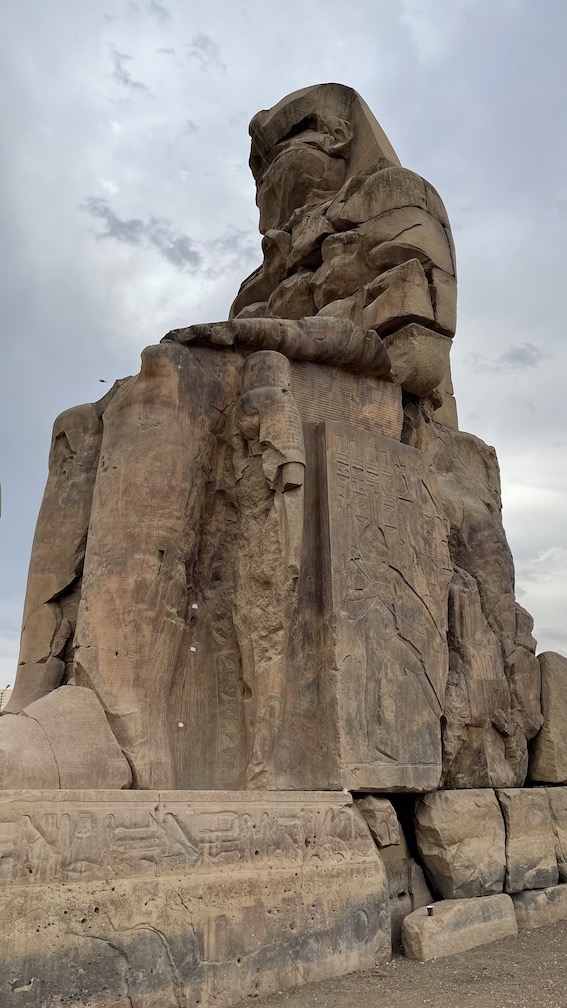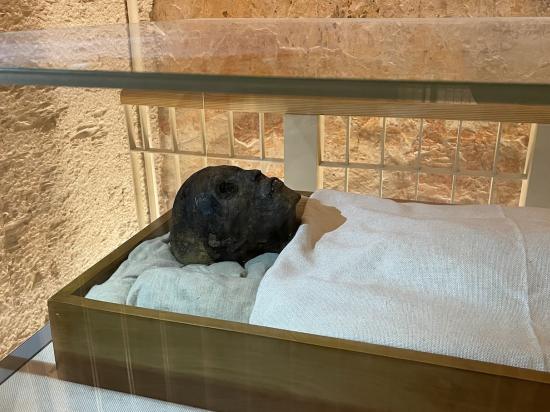The Colossi of Memnon
The Colossi of Memnon are a pair of massive stone statues located in the Theban necropolis in Luxor, Egypt. In antiquity, they were thought to be representations of the mythological Greek King Memnon.

They are situated on the west bank of the Nile River, facing east towards the sunrise. The statues are approximately 18 meters (60 feet) tall and depict the Pharaoh Amenhotep III, who reigned in Egypt during the 18th dynasty.
Amenhotep III was an ancient Egyptian pharaoh who reigned during the 18th dynasty, from approximately 1391 to 1353 BC. He was the son of the pharaoh Thutmose IV and his queen Mutemwiya, and he ascended to the throne at a young age, possibly around 12 years old.
 He was undoupbtetly one of the greates pharaos and is known for his many building projects, including the construction of several temples, statues, and monuments throughout Egypt. He was particularly known for his grand mortuary temple in western Thebes, which was one of the largest and most impressive temples of its time. The temple was dedicated to the god Amun and included two large, seated statues of Amenhotep III, which are now known as the Colossi of Memnon.
He was undoupbtetly one of the greates pharaos and is known for his many building projects, including the construction of several temples, statues, and monuments throughout Egypt. He was particularly known for his grand mortuary temple in western Thebes, which was one of the largest and most impressive temples of its time. The temple was dedicated to the god Amun and included two large, seated statues of Amenhotep III, which are now known as the Colossi of Memnon.
Amenhotep III was also known for his diplomatic skills and his efforts to maintain peace and stability within his kingdom. He established friendly relationships with other nations, including the Hittites, and was known for his extensive diplomatic correspondence.
During his reign, Amenhotep III was also responsible for commissioning some of the most beautiful and well-preserved art and artifacts from ancient Egypt, including many exquisite statues and reliefs that are now on display in museums around the world.
Amenhotep III was succeeded by his son, Amenhotep IV, who later changed his name to Akhenaten and is famous for his religious reforms and his focus on worshiping the sun god, Aten.
His son ignited a revolution in Egypt by banning Amun, main God of the realm and his fellow Gods and Goddesses and worshipping only one God, the Aten. He and his wife Nefertiti cut out the priesthood as they were the only mediators between the people and the Aten and left ancient Thebes - today's Luxor - to build a new capital city some 300 km North in the middle of the dessert and called it Achetaten - the Horizon of Aten.
 The Colossi of Memnon were constructed around 1350 BC and were originally situated in front of Amenhotep III's mortuary temple. The temple was destroyed by floods and earthquakes, but the statues remained standing. They became famous in antiquity for a curious phenomenon: at sunrise, the northern statue emitted a musical sound that was said to resemble the sound of a lyre. This sound was attributed to the statue "singing" to its mother, the goddess Eos, as she welcomed the sun.
The Colossi of Memnon were constructed around 1350 BC and were originally situated in front of Amenhotep III's mortuary temple. The temple was destroyed by floods and earthquakes, but the statues remained standing. They became famous in antiquity for a curious phenomenon: at sunrise, the northern statue emitted a musical sound that was said to resemble the sound of a lyre. This sound was attributed to the statue "singing" to its mother, the goddess Eos, as she welcomed the sun.
The "singing" of the Colossi of Memnon was said to be a sign of good luck and a powerful omen. Visitors came from all over the ancient world to hear the sound and to pay tribute to the pharaoh. The phenomenon was so well-known that the statues became known as the "Vocal Memnon" and were featured in many ancient Greek and Roman writings, including those of Strabo and Pausanias, as well as Emperor Hadrian.
In reality, the sound was most likely caused by the natural effects of the rising sun on the porous limestone of the statue. The phenomenon ceased in 199 AD, when the northern statue was damaged in an earthquake and the crack that formed silenced the sound. Today, visitors can still see the Colossi of Memnon and marvel at their imposing size and historical significance.
During the last years, the area of mortuary temple of Amenhotep III was extensively researched and a third colossus was assembled by the archeologists and now rises into the Egyptian sky, just behind the "old" colossi.

Who nows, maybe there will be 4 colossi in the near future.








